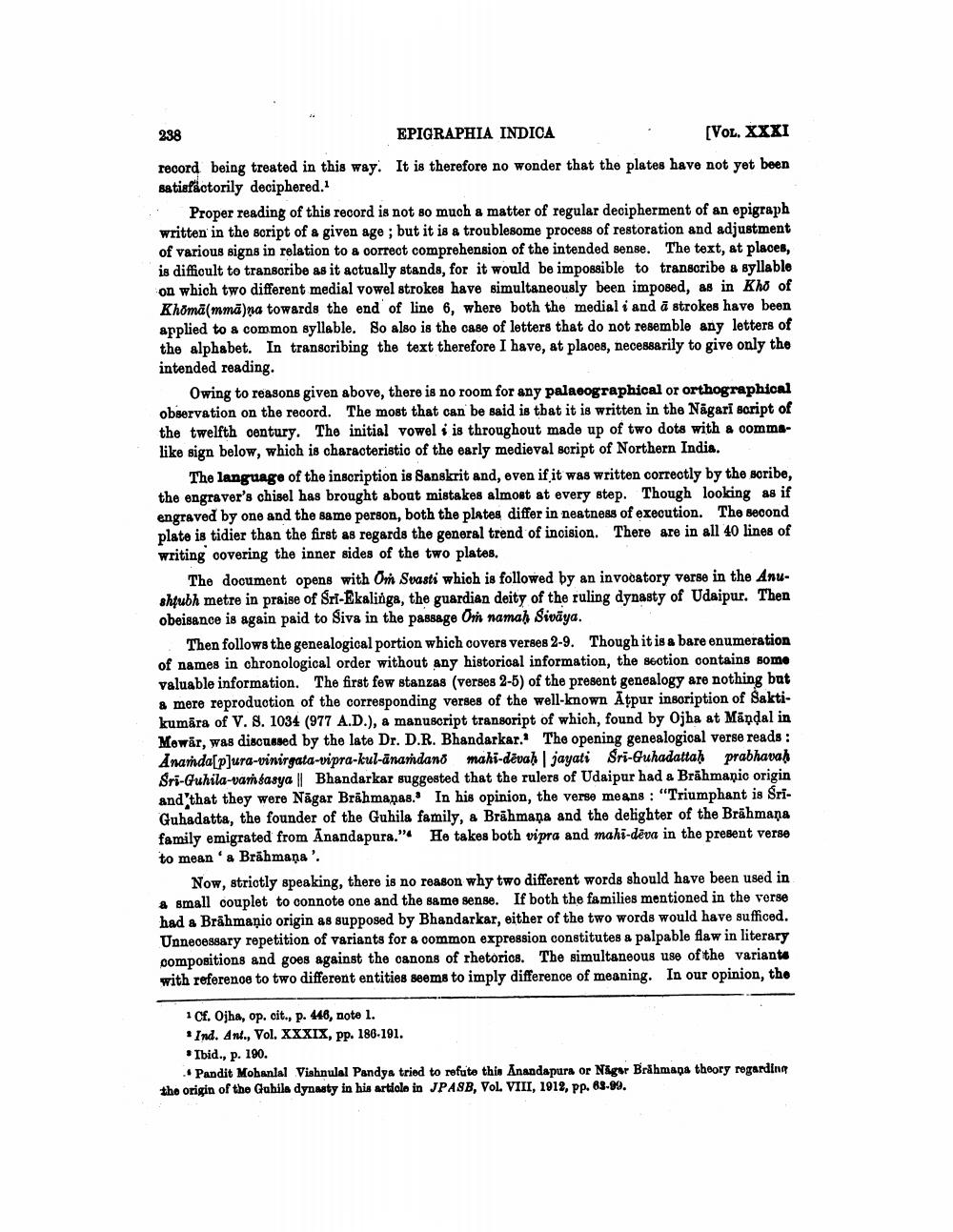________________
238
EPIGRAPHIA INDICA
[VOL. XXXI
record being treated in this way. It is therefore no wonder that the plates have not yet been satisfactorily deciphered.
Proper reading of this record is not so much a matter of regular decipherment of an epigraph written in the script of a given age ; but it is a troublesome process of restoration and adjustment of various signs in relation to a correct comprehension of the intended sense. The text, at places, is difficult to transoribe as it actually stands, for it would be impossible to transcribe a syllable on which two different medial vowel strokes have simultaneously been imposed, as in Kho of Khomā(mmā)na towards the end of line 6, where both the medial i and a strokes have been applied to a common syllable. So also is the case of letters that do not resemble any letters of the alphabet. In transcribing the text therefore I have, at places, necessarily to give only the intended reading.
Owing to reasons given above, there is no room for any palaeographical or orthographical observation on the record. The most that can be said is that it is written in the Nagari script of the twelfth century. The initial vowel i is throughout made up of two dots with a commalike sign below, which is characteristic of the early medieval script of Northern India.
The language of the inscription is Sanskrit and, even if it was written correctly by the scribe, the engraver's chisel has brought about mistakes almost at every step. Though looking as if engraved by one and the same person, both the plates differ in neatness of execution. The second plate is tidier than the first as regards the general trend of incision. There are in all 40 lines of writing covering the inner sides of the two plates.
The document opens with Om Svasti which is followed by an invocatory verse in the Anushtubh metre in praise of Sri-Ekalinga, the guardian deity of the ruling dynasty of Udaipur. Then obeisance is again paid to Siva in the passage Om namah Sivaya.
Then follows the genealogical portion which covers verdes 2-9. Though it is a bare enumeration of names in chronological order without any historical information, the section contains some valuable information. The first few stanzas (verses 2-5) of the present genealogy are nothing but & mere reproduction of the corresponding verses of the well-known Atpur insoription of Saktikumāra of V. 8. 1034 (977 A.D.), a manuscript transoript of which, found by Ojha at Mandal in Mowar, was discussed by the late Dr. D.R. Bhandarkar. The opening genealogical verse reads : Ananda[p]ura-vinirgata-vipra-kul-anandano mahi-devah jayati Sri-Guhadattah prabhavah Sri-Guhila-vartasya || Bhandarkar suggested that the rulers of Udaipur had a Brāhmaṇic origin and that they were Nägar Brāhmaṇas.' In his opinion, the verse means : "Triumphant is SriGuhadatta, the founder of the Guhila family, a Brāhmaṇa and the delighter of the Brāhmaņa family emigrated from Anandapura." He takes both vipra and mahi-deva in the present verse to mean'a Brāhmana'.
Now, strictly speaking, there is no reason why two different words should have been used in & small couplet to connote one and the same sense. If both the families mentioned in the verse had a Brāhmaṇio origin &s supposed by Bhandarkar, either of the two words would have sufficed. Unnecessary repetition of variants for a common expression constitutes a palpable flaw in literary compositions and goes against the canons of rhetorics. The simultaneous use of the variants with reference to two different entities seems to imply difference of meaning. In our opinion, the
1 Cf. Ojha, op. cit., p. 446, note 1. * Ind. Ant., Vol. XXXIX, pp. 186-191.
Ibid., p. 190. .. Pandit Mohanlal Vishnulal Pandya tried to refute thin Anandapura or Niger Brahmana theory regarding the origin of the Gabila dynasty in his article in JPASB, VOL. VIII, 1912, pp. 89-99.




